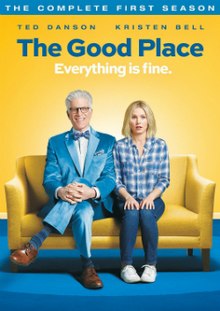By now, many of you have probably heard of “The Good Place”.Created by Michael Schur, who previously worked on “The Office”and “Parks and Recreation”, “The Good Place”is a fresh take on the sitcom formula.
With a stellar cast comprised of Kristen Bell, who makes a seamless transition to the small screen, “Cheers” alum Ted Danson, and a breakout role for William Jackson Harper, the characters become more loveable as the show goes on. Twists and turns abound, keeping the audience engaged.
The show begins when we meet Bell’s character, Eleanor Shellstrop. After being informed of her death, albeit from a comedic accident, she finds herself in the afterlife—in The Good Place.
Eleanor is told by Ted Danson’s Michael, an eternal being who resides in The Good Place, that each of her actions on Earth were weighed, and that she ultimately proved herself to be a good person as a hardworking philanthropist. As such, she wound up in The Good Place—a selective heavenlike place where beings like Michael construct special neighborhoods for souls in the afterlife to live.
Here she is paired up with Chidi Anagonye, a moral philosophy professor who is supposed to be her soulmate. However, things get complicated when Eleanor reveals to Chidi that she does not belong in The Good Place. There’s been a mix-up; Eleanor was not, in fact, a ‘good person’, and was selfish and rude to others during her time on Earth.
As her confidant and a professor, Chidi and Eleanor decide it is in their best interests to educate and improve Eleanor’s habits and hopefully make her worthy of being in The Good Place. That said, one would expect the show to be about Eleanor and Chidi’s adventures in The Good Place, as Eleanor tries to become a better person.
However, this is where the show’s real trademark comes through. Each episode that follows subverts the plot set up by the previous episode—a welcome break from the classic sitcom formula.
As far as sitcoms go, most shows follow a basic plot, from “Friends” to “How I Met Your Mother” to “Parks and Recreation”. The characters are presented with a problem, and are paired off into different groups. Throughout the course of the episode, the pairings make room for character growth and humorous situations. At the end of the day, all their problems are solved, and the formula is rinsed and repeated for the entirety of the series.
“The Good Place” follows this formula loosely, as the characters are paired differently in each episode, and the dynamics between them give insight into the type of people they were on Earth. As the first season progresses however, each episode ends with a new revelation or twist that impacts the next episode, and the main characters’ problems only get worse.
Without revealing the plot twist of the first season, it is best to note that the show only grows from there. Season 2 continued to push the boundaries of the show, undoing all the plot development that was set in motion in the first season, and Season 3 is no different. “The Good Place” is a pleasant change from the traditional sitcom and is definitely worth a watch for those seeking a new obsession.




























